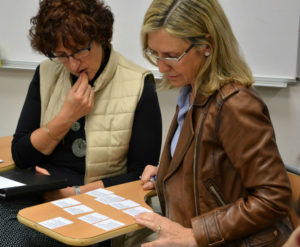Special Educational Needs & Disabilities
In-house teacher training
This course is also available online
1 week
Course Length
Flexible
Lesson Days
15
Lessons
English
Language
B1
Minimum Level
Overview
This course develops the skills of those involved in the education of pupils with Special Educational Needs and/or Disabilities (SEND) so that these children are able to achieve their full potential in schools.
After considering the key principles of inclusive practice, participants will develop a thorough understanding of the most frequently diagnosed forms of SEND and explore practical strategies that will support these children to achieve in the classroom and participate in the wider life of the school.
Participants will also consider how children with SEND can be supported socially and pastorally by working alongside families and friends to enhance social inclusion.
Completing this course will help you:
- Understand the key principles of inclusion within education
- Develop knowledge of the most common Special Educational Needs such as Autistic Spectrum Disorder (ADHD), Attention Deficit Hyperactivity Disorder (ADHD), speech and language difficulties and dyslexia
- Explore strategies and interventions to support children with SEND in the classroom and wider school life
- Consider how to adapt the physical and emotional environment to support children with SEND
- Explore effective strategies for working alongside families and friends to support the education and social inclusion of children with SEND.
Who is the course for?
For teachers who want to acquire knowledge of exploring effective strategies for working alongside families and friends to support the education and social inclusion of children with SEND.
Course Sample programme
| Week 1 | Course Content |
| Day One | Key principles of inclusion within education. |
| Day Two | Develop knowledge of the most common Special Educational Needs |
| Day Three | Explore strategies and interventions to support children with SEND |
| Day Four | Consider how to adapt the physical and emotional environment to support children with SEND. |
| Day Five | Review and Feedback |
*Please note that the course content may be subject to change due to latest methodology trends updates. 1 lesson=45mins
Share This Class:
What people are saying



In-House Training
You might also be interested in these courses

Higher Order Thinking
Developing Higher Order Thinking requires teachers to establish with their student a knowledge base of thinking skills, reasoning, critical thought, and problem-solving…

Scaffolding
With our workshop “Scaffolding” you will understand in more details on how to support second language learners by providing helpful hints to help students…

Technology in the Classroom
The course will introduce to a range of technologies to enhance teaching and learning, including a number of highly accessible and free apps for use on smartphones and tablets.
More Courses in the UK, Ireland and Malta
You might also be interested in these courses

Technology for Language Teachers
Technology for Language teachers is aimed at teachers who want to use more technology in the classroom to enhance the learning experience of their students…

Teaching for Exam Classes
Teaching for Exam Classes is for English teachers who are preparing teenage or adult students for exams. Preparing to teach Cambridge or IELTS exam class. London…

Pronunciation and Performance with an expert “Adrian Underhill”
Pronunciation and Performance with an expert is a course led by a world-renowned ELT Consultant and Trainer. Adrian Underhill is an author and the series…
Methodologies

Total Physical Response
Total Physical Response is considered to be an excellent way of learning vocabulary. Moreover, since it is based on commands, the students can easily learn the meaning of the words in the target language.

The Structural Approach
This method is based on the opinion that it is imperative to understand the structures of the language. Understanding the complexities of the structures of the sentences in a language is more important than learning the vocabulary of the language.

The Direct Method
This method primarily focuses on the development of oral skills. One of the most important characteristic feature of this method is that visual materials and real-life objects are used. Moreover, such an oral training helps in reading and writing. There is no translation involved in this method.
